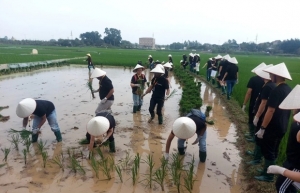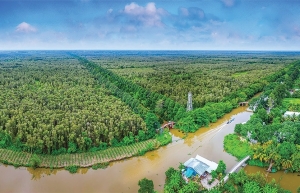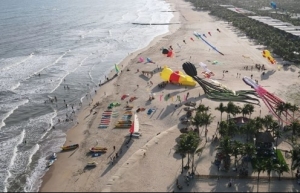Travel for the future
Developing green tourism has become an urgent practical need to help increase the numbers of wealthier tourists. According to Tripadvisor, 34 per cent of tourists are willing to pay more to stay in environmentally friendly hotels and half of international tourists are willing to pay more for travel companies that benefit the community and conservation.
 |
| Travel for the future |
At the Sustainable Green Tourism Development forum held at the end of last month, Nguyen Trung Khanh, director of the Vietnam National Authority of Tourism, said that climate change and environmental degradation were negatively impacting tourism, but motivating the tourism industry to transform.
“Tourism has become an important economic sector, expected to contribute more than 6.4 per cent to Vietnam’s GDP this year. Therefore, green transformation and tourism are stories of national revival, linked to ecosystems,” Khanh said. “In the past, tourists considered tourism to be about experiencing, exploring, and enjoying services. Now, 90 per cent of tourists want to contribute to the community and culture when travelling. This is a huge change.”
Annual environmental monitoring results of the Ministry of Natural Resources and Environment show that on average, each tourist generates 1.2 kilogrammes of rubbish per day. Each non-stay tourist has an average amount of waste of 0.5kg a day. Of which, plastic bags, plastic cups, and foam boxes account for about 60 per cent.
In Vietnam, the south-central province of Quang Nam is considered a pioneer in green tourism, striving to become a green tourism centre to protect the ecological environment, prioritise recycled products, and limit emissions.
Since 2020, Quang Nam’s tourist town of Hoi An has called on the business community and tourists to limit and minimise single-use plastic items, striving to ban single-use and non-degradable plastic bags by 2025.
Co To island district in the northeastern province of Quang Ninh has also become a bright spot for green tourism. According to the People’s Committee of Co To, there was a period during the peak tourist season, where every day Co To had to collect 20-30 tonnes of waste, of which, plastic waste alone accounted for one to two tonnes a day.
Since 2020, Co To has approved the project to ban plastic waste by 2025 and piloted a regulation that tourists must not bring plastic bottles, nylon bags, or materials that are at risk of causing environmental pollution to the island. All travel companies in Co To have registered to organise green tours, all restaurants, hotels, and small businesses have committed not to use single-use plastic products.
Along with Hoi An and Co To, many green destinations, green accommodation facilities, and green tourism products are also being formed in other localities such as Ninh Binh, Ninh Thuan, and Con Dao. However, the number of green conversion units is still minimal.
In Vietnam, the Ministry of Culture, Sports, and Tourism has so far not yet issued any specific legal guidelines for recognising “green tourism enterprises.”
According to Le Thi Le Thanh, director of the Department of Tourism of the south-central province of Khanh Hoa, Vietnam should learn from advanced practices and models. For example, the Maldives has issued a methodical and scientific investment and tourism development policy towards sustainable development. Resorts on the islands must have no more than 30 per cent construction area, no building can be higher than the top of a coconut tree, and at least 45 per cent of employees working at the resort must be Maldivian nationals.
“Transforming green tourism is not only a matter of greening the tourist space and protecting the ecological environment, but also requires a change in the thinking of tourism workers and proper behaviour with nature,” Thanh said.
Vo Tri Thanh, director of the Institute for Brand and Competitiveness Strategy, said that Vietnam was facing two big challenges in green tourism. First is the difficulty in changing, transforming from awareness into action of businesses, tourists, and people at the destination in the tourism ecosystem; second is the story of competition, as going green is now not only a political commitment but also a national action strategy and a demand of the market itself.
“If we do not keep up the pace, the competitiveness of Vietnamese tourism will fall, especially with so many other countries with attractive tourism in the region,” he said.
According to Patrick Haverman, deputy representative of the United Nations Development Programme in Vietnam, green transformation in Vietnamese tourism needs to focus on green planning and effective destination management, plastic-free and low-carbon tourism, and sustainable tourism based on nature.
“Vietnam still has much to do to enhance the effectiveness of tourism destination management. There needs to be involvement and leadership from local authorities, alongside close coordination with the private sector and local communities,” he said.
 | Hanoi promotes experiential tourism linked to heritage, trade villages Hanoi, home to a large number of cultural and historical sites and craft villages, is taking measures to develop experiential tourism to attract more visitors to the over-1,000-year-old capital. |
 | Hau Giang to turn tourism into top spearhead sector The Mekong Delta province of Hau Giang is sparing no effort to best avail of bountiful local resources to drive its development. |
 | Ba Ria - Vung Tau joins in on green tourism trend Various measures are being taken by authorities and businesses in the southern province of Ba Ria - Vung Tau to keep up with the green tourism trend to attract more travellers. |
What the stars mean:
★ Poor ★ ★ Promising ★★★ Good ★★★★ Very good ★★★★★ Exceptional
Related Contents
Latest News
More News
- Vietjet launches daily Manila flights to celebrate year-end festive peak season (December 05, 2025 | 13:47)
- The destinations powering Vietnam’s festive season travel demand (December 04, 2025 | 18:33)
- Vietnam named among the world’s most exciting winter destinations (December 04, 2025 | 15:10)
- Phu Tho emerges as northern Vietnam’s new tourism hub (December 01, 2025 | 17:00)
- Vietjet completes Airbus A320/A321 updates ahead of deadline (December 01, 2025 | 09:49)
- Vietjet resumes Con Dao flights from early December (November 28, 2025 | 15:24)
- Free tickets, Lunar New Year promotions on offer at Vietjet Mega Livestream (November 26, 2025 | 15:32)
- Scandinavian Airlines and Vietnam Airlines broaden agreement with new routes (November 25, 2025 | 17:04)
- Halong Cruise Port welcomes over 3,100 international visitors (November 12, 2025 | 18:06)
- Vietnam.travel climbs to second place in Southeast Asia website rankings (November 12, 2025 | 18:01)

 Tag:
Tag:


















 Mobile Version
Mobile Version